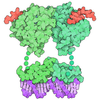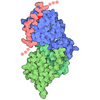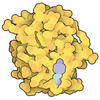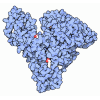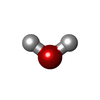+ Open data
Open data
- Basic information
Basic information
| Entry | Database: PDB / ID: 9h66 | ||||||
|---|---|---|---|---|---|---|---|
| Title | Steroidal Selective Modulators of FXR with Therapeutic Potential | ||||||
 Components Components |
| ||||||
 Keywords Keywords | NUCLEAR PROTEIN / nuclear receptor / ligand binding domain / complex | ||||||
| Function / homology |  Function and homology information Function and homology information: / chenodeoxycholic acid binding / positive regulation of phosphatidic acid biosynthetic process / : / positive regulation of ammonia assimilation cycle / regulation of low-density lipoprotein particle clearance / intracellular triglyceride homeostasis / cellular response to bile acid / negative regulation of very-low-density lipoprotein particle remodeling / negative regulation of interleukin-1 production ...: / chenodeoxycholic acid binding / positive regulation of phosphatidic acid biosynthetic process / : / positive regulation of ammonia assimilation cycle / regulation of low-density lipoprotein particle clearance / intracellular triglyceride homeostasis / cellular response to bile acid / negative regulation of very-low-density lipoprotein particle remodeling / negative regulation of interleukin-1 production / regulation of bile acid biosynthetic process / regulation of insulin secretion involved in cellular response to glucose stimulus / negative regulation of monocyte chemotactic protein-1 production / toll-like receptor 9 signaling pathway / nuclear receptor-mediated bile acid signaling pathway / bile acid nuclear receptor activity / bile acid metabolic process / bile acid binding / cell-cell junction assembly / cellular response to fatty acid / regulation of cholesterol metabolic process / RNA polymerase II intronic transcription regulatory region sequence-specific DNA binding / negative regulation of interleukin-2 production / bile acid and bile salt transport / intracellular glucose homeostasis / locomotor rhythm / positive regulation of interleukin-17 production / aryl hydrocarbon receptor binding / negative regulation of interleukin-6 production / negative regulation of type II interferon production / cellular response to Thyroglobulin triiodothyronine / regulation of lipid metabolic process / regulation of glucose metabolic process / Synthesis of bile acids and bile salts / negative regulation of tumor necrosis factor production / negative regulation of tumor necrosis factor-mediated signaling pathway / Synthesis of bile acids and bile salts via 27-hydroxycholesterol / Endogenous sterols / positive regulation of insulin receptor signaling pathway / Synthesis of bile acids and bile salts via 7alpha-hydroxycholesterol / fatty acid homeostasis / positive regulation of insulin secretion involved in cellular response to glucose stimulus / nuclear retinoid X receptor binding / cellular response to hormone stimulus / Recycling of bile acids and salts / transcription regulator inhibitor activity / intracellular receptor signaling pathway / Notch signaling pathway / : / positive regulation of adipose tissue development / Regulation of lipid metabolism by PPARalpha / negative regulation of canonical NF-kappaB signal transduction / peroxisome proliferator activated receptor signaling pathway / regulation of cellular response to insulin stimulus / BMAL1:CLOCK,NPAS2 activates circadian expression / SUMOylation of transcription cofactors / Activation of gene expression by SREBF (SREBP) / response to progesterone / cholesterol homeostasis / nuclear receptor binding / transcription coregulator binding / negative regulation of smoothened signaling pathway / RNA polymerase II transcription regulatory region sequence-specific DNA binding / SUMOylation of intracellular receptors / circadian regulation of gene expression / mRNA transcription by RNA polymerase II / Heme signaling / euchromatin / Transcriptional activation of mitochondrial biogenesis / Activated PKN1 stimulates transcription of AR (androgen receptor) regulated genes KLK2 and KLK3 / PPARA activates gene expression / Cytoprotection by HMOX1 / Nuclear Receptor transcription pathway / Transcriptional regulation of white adipocyte differentiation / negative regulation of inflammatory response / RNA polymerase II transcription regulator complex / nuclear receptor activity / : / HATs acetylate histones / cellular response to lipopolysaccharide / MLL4 and MLL3 complexes regulate expression of PPARG target genes in adipogenesis and hepatic steatosis / DNA-binding transcription activator activity, RNA polymerase II-specific / transcription regulator complex / Estrogen-dependent gene expression / sequence-specific DNA binding / transcription by RNA polymerase II / DNA-binding transcription factor activity, RNA polymerase II-specific / cell differentiation / transcription coactivator activity / receptor complex / transcription cis-regulatory region binding / protein dimerization activity / defense response to bacterium / nuclear speck / nuclear body / RNA polymerase II cis-regulatory region sequence-specific DNA binding / inflammatory response / DNA-binding transcription factor activity / protein domain specific binding / innate immune response Similarity search - Function | ||||||
| Biological species |  Homo sapiens (human) Homo sapiens (human) | ||||||
| Method |  X-RAY DIFFRACTION / X-RAY DIFFRACTION /  SYNCHROTRON / SYNCHROTRON /  MOLECULAR REPLACEMENT / Resolution: 2.6 Å MOLECULAR REPLACEMENT / Resolution: 2.6 Å | ||||||
 Authors Authors | Kydd-Sinclair, D. / Watson, K.A. | ||||||
| Funding support | 1items
| ||||||
 Citation Citation |  Journal: J.Mol.Biol. / Year: 2025 Journal: J.Mol.Biol. / Year: 2025Title: Structural Basis of Novel Bile Acid-Based Modulators of FXR. Authors: Kydd-Sinclair, D. / Packer, G.L. / Weymouth-Wilson, A.C. / Watson, K.A. | ||||||
| History |
|
- Structure visualization
Structure visualization
| Structure viewer | Molecule:  Molmil Molmil Jmol/JSmol Jmol/JSmol |
|---|
- Downloads & links
Downloads & links
- Download
Download
| PDBx/mmCIF format |  9h66.cif.gz 9h66.cif.gz | 258.7 KB | Display |  PDBx/mmCIF format PDBx/mmCIF format |
|---|---|---|---|---|
| PDB format |  pdb9h66.ent.gz pdb9h66.ent.gz | 169.4 KB | Display |  PDB format PDB format |
| PDBx/mmJSON format |  9h66.json.gz 9h66.json.gz | Tree view |  PDBx/mmJSON format PDBx/mmJSON format | |
| Others |  Other downloads Other downloads |
-Validation report
| Summary document |  9h66_validation.pdf.gz 9h66_validation.pdf.gz | 1.4 MB | Display |  wwPDB validaton report wwPDB validaton report |
|---|---|---|---|---|
| Full document |  9h66_full_validation.pdf.gz 9h66_full_validation.pdf.gz | 1.4 MB | Display | |
| Data in XML |  9h66_validation.xml.gz 9h66_validation.xml.gz | 44.7 KB | Display | |
| Data in CIF |  9h66_validation.cif.gz 9h66_validation.cif.gz | 58.4 KB | Display | |
| Arichive directory |  https://data.pdbj.org/pub/pdb/validation_reports/h6/9h66 https://data.pdbj.org/pub/pdb/validation_reports/h6/9h66 ftp://data.pdbj.org/pub/pdb/validation_reports/h6/9h66 ftp://data.pdbj.org/pub/pdb/validation_reports/h6/9h66 | HTTPS FTP |
-Related structure data
| Related structure data |  9h65C  4qe6 S: Starting model for refinement C: citing same article ( |
|---|---|
| Similar structure data | Similarity search - Function & homology  F&H Search F&H Search |
- Links
Links
- Assembly
Assembly
| Deposited unit | 
| ||||||||||||
|---|---|---|---|---|---|---|---|---|---|---|---|---|---|
| 1 | 
| ||||||||||||
| 2 | 
| ||||||||||||
| 3 | 
| ||||||||||||
| Unit cell |
|
- Components
Components
| #1: Protein | Mass: 27100.191 Da / Num. of mol.: 4 / Mutation: E277A, E350A Source method: isolated from a genetically manipulated source Source: (gene. exp.)  Homo sapiens (human) / Gene: NR1H4, BAR, FXR, HRR1, RIP14 / Production host: Homo sapiens (human) / Gene: NR1H4, BAR, FXR, HRR1, RIP14 / Production host:  #2: Protein/peptide | Mass: 1593.844 Da / Num. of mol.: 6 / Source method: obtained synthetically / Details: Steroid receptor coactivator 2 peptide 3 (SRC2-3) / Source: (synth.)  Homo sapiens (human) / References: UniProt: Q15596 Homo sapiens (human) / References: UniProt: Q15596#3: Chemical | ChemComp-R3U / ( Mass: 661.788 Da / Num. of mol.: 4 / Source method: obtained synthetically / Formula: C33H47F4NO6S / Feature type: SUBJECT OF INVESTIGATION #4: Water | ChemComp-HOH / | Has ligand of interest | Y | Has protein modification | Y | |
|---|
-Experimental details
-Experiment
| Experiment | Method:  X-RAY DIFFRACTION / Number of used crystals: 1 X-RAY DIFFRACTION / Number of used crystals: 1 |
|---|
- Sample preparation
Sample preparation
| Crystal | Density Matthews: 3.13 Å3/Da / Density % sol: 60.68 % |
|---|---|
| Crystal grow | Temperature: 295 K / Method: vapor diffusion, sitting drop / pH: 4.2 Details: 0.1M sodium phosphate dibasic, 0.2M lithium sulphate pH4.2, 20% PEG2000 MME |
-Data collection
| Diffraction | Mean temperature: 100 K / Serial crystal experiment: N |
|---|---|
| Diffraction source | Source:  SYNCHROTRON / Site: SYNCHROTRON / Site:  Diamond Diamond  / Beamline: I03 / Wavelength: 0.9763 Å / Beamline: I03 / Wavelength: 0.9763 Å |
| Detector | Type: DECTRIS EIGER2 X 16M / Detector: PIXEL / Date: Jul 10, 2021 |
| Radiation | Protocol: SINGLE WAVELENGTH / Monochromatic (M) / Laue (L): M / Scattering type: x-ray |
| Radiation wavelength | Wavelength: 0.9763 Å / Relative weight: 1 |
| Reflection | Resolution: 2.6→57.92 Å / Num. obs: 44957 / % possible obs: 99.96 % / Redundancy: 6.4 % / Biso Wilson estimate: 66.65 Å2 / CC1/2: 0.902 / CC star: 0.974 / Rmerge(I) obs: 0.137 / Rrim(I) all: 0.1498 / Net I/σ(I): 8.83 |
| Reflection shell | Resolution: 2.6→2.693 Å / Rmerge(I) obs: 2.978 / Num. unique obs: 4461 / CC1/2: 0.519 |
- Processing
Processing
| Software |
| |||||||||||||||||||||||||||||||||||||||||||||||||||||||||||||||||||||||||||||||||||||||||||||||||||||||||||||||||||||||
|---|---|---|---|---|---|---|---|---|---|---|---|---|---|---|---|---|---|---|---|---|---|---|---|---|---|---|---|---|---|---|---|---|---|---|---|---|---|---|---|---|---|---|---|---|---|---|---|---|---|---|---|---|---|---|---|---|---|---|---|---|---|---|---|---|---|---|---|---|---|---|---|---|---|---|---|---|---|---|---|---|---|---|---|---|---|---|---|---|---|---|---|---|---|---|---|---|---|---|---|---|---|---|---|---|---|---|---|---|---|---|---|---|---|---|---|---|---|---|---|---|
| Refinement | Method to determine structure:  MOLECULAR REPLACEMENT MOLECULAR REPLACEMENTStarting model: 4QE6  4qe6 Resolution: 2.6→57.92 Å / SU ML: 0.6189 / Cross valid method: FREE R-VALUE / σ(F): 1.91 / Phase error: 41.1554 Stereochemistry target values: GeoStd + Monomer Library + CDL v1.2
| |||||||||||||||||||||||||||||||||||||||||||||||||||||||||||||||||||||||||||||||||||||||||||||||||||||||||||||||||||||||
| Solvent computation | Shrinkage radii: 0.9 Å / VDW probe radii: 1.11 Å / Solvent model: FLAT BULK SOLVENT MODEL | |||||||||||||||||||||||||||||||||||||||||||||||||||||||||||||||||||||||||||||||||||||||||||||||||||||||||||||||||||||||
| Displacement parameters | Biso mean: 81.19 Å2 | |||||||||||||||||||||||||||||||||||||||||||||||||||||||||||||||||||||||||||||||||||||||||||||||||||||||||||||||||||||||
| Refinement step | Cycle: LAST / Resolution: 2.6→57.92 Å
| |||||||||||||||||||||||||||||||||||||||||||||||||||||||||||||||||||||||||||||||||||||||||||||||||||||||||||||||||||||||
| Refine LS restraints |
| |||||||||||||||||||||||||||||||||||||||||||||||||||||||||||||||||||||||||||||||||||||||||||||||||||||||||||||||||||||||
| LS refinement shell |
|
 Movie
Movie Controller
Controller



 PDBj
PDBj